Climate Variability and Adaptation Strategies in a Pastoralist Area of the Eastern Bale Zone: The Case of Sawena District, Ethiopia
Abstract
:1. Introduction
1.1. Climate Variability and Pastoralism
1.2. Theoretical Background
1.3. Research Gap and the Objective of the Study
2. Materials and Methods
2.1. The Study Area
2.2. Data Source and Type
2.2.1. Secondary Data About Climate Variability
2.2.2. Primary Data Collection
2.3. Method of Data Analysis
2.3.1. Trend and Variability Analysis for Climate Data
2.3.2. Analysis of Variables Affecting Adaptation to Climate Change
3. Results
3.1. Descriptive Statistics for Primary and Secondary Variables
3.2. Trend and Variability of Rainfall and Temperature
3.2.1. Trend and Variability of Rainfall
3.2.2. Trend and Variability of Temperature
3.3. Household Adaptation and Coping Strategies and Their Determinants
3.3.1. Household Adaptation and Coping Strategies Toward Climate Variability
3.3.2. Determinants of Household Adaptation and Coping Strategies
4. Discussion
5. Conclusions and Policy Recommendations
5.1. Conclusions
5.2. Policy Recommendations
5.2.1. Strengthen Climate Adaptation Strategies
5.2.2. Improve Access to Resources and Services
5.2.3. Address Temperature and Rainfall Variability
Author Contributions
Funding
Institutional Review Board Statement
Informed Consent Statement
Data Availability Statement
Conflicts of Interest
References
- Guye, M.H.; Abiyot, L.; Yimer, M. Existential threats to pastoralism in an arid environment: The fate of Gujii pastoralists in Southern Ethiopia. J. Degrad. Min. Lands Manag. 2023, 10, 4179–4190. [Google Scholar] [CrossRef]
- Ministry of Agriculture (MoA). Ethiopia Country Programming Paper to End Drought Emergencies in the Horn of Africa; Ministry of Agriculture: Addis Ababa, Ethiopia, 2012; pp. 1–26.
- IGAD Centre for Pastoral Areas and Livestock Development (ICPALD). Total Economic Valuation of Pastoralism in Ethiopia—Study Report; IGAD Centre for Pastoral Areas and Livestock Development: Nairobi, Kenya, 2020; pp. 1–27. [Google Scholar]
- Shapiro, B.I.; Gebru, G.; Desta, S.; Negassa, A.; Nigussie, K.; Aboset, G.; Mechale, H. Ethiopia livestock sector analysis: A 15-year livestock sector strategy. In ILRI Project Report; ILRI: Addis Ababa, Ethiopia, 2017. [Google Scholar]
- Abduletif, A.A. Benefits and challenges of pastoralism system in Ethiopia. Stud. Mundi-Econ. 2019, 6, 56–67. [Google Scholar]
- Salachna, A.; Marcol, K.; Broda, J.; Chmura, D. The Contribution of Environmental and Cultural Aspects of Pastoralism in the Provision of Ecosystem Services: The Case of the Silesian Beskid Mts (Southern Poland). Sustainability 2022, 14, 10020. [Google Scholar] [CrossRef]
- IGAD Centre for Pastoral Areas and Livestock Development (ICPALD). Policies and Proclamations Relevant to Pastoral Areas Land Management for Ethiopia, Kenya, and Uganda Review Report 2016; IGAD Centre for Pastoral Areas and Livestock Development: Nairobi, Kenya, 2017; pp. 1–52. [Google Scholar]
- Manzano, P.; Burgas, D.; Cadahía, L.; Eronen, J.T.; Fernández-Llamazares, A.; Bencherif, S.; Holand, Ø.; Seitsonen, O.; Byambaa, B.; Fortelius, M.; et al. Toward a holistic understanding of pastoralism. One Earth 2021, 4, 651–665. [Google Scholar] [CrossRef]
- Perley, C.J.K. Pastoral Agriculture in the Post-industrial Age: Building Functional Integrity and Realising Potential. Front. Sustain. Food Syst. 2021, 5, 552838. [Google Scholar] [CrossRef]
- Shibru, M.; Opere, A.; Omondi, P.; Gichaba, M. Understanding physical climate risks and their implication for community adaptation in the borana zone of southern Ethiopia using mixed-methods research. Sci. Rep. 2023, 13, 6916. [Google Scholar] [CrossRef]
- United Nations Office for the Coordination of Humanitarian Affairs (OCHA). Ethiopia: Drought Update. 2022. Available online: https://reliefweb.int/report/ethiopia/ethiopia-drought-update-no-4-june-2022 (accessed on 12 August 2024).
- Tofu, D.A.; Fana, C.; Dilbato, T.; Dirbaba, N.B.; Tesso, G. Pastoralists’ and agro-pastoralists’ livelihood resilience to climate change-induced risks in the Borana zone, south Ethiopia: Using resilience index measurement approach. Pastoralism 2023, 13, 4. [Google Scholar] [CrossRef]
- Gebremeskel, E.N.; Solomon Desta, S.; Kassa, G.K. Pastoral development in Ethiopia. In Trends and the Way Forward. Development Knowledge and Learning; World Bank and the International Fund for Agricultural Development (IFAD); World Bank: Washington, DC, USA, 2019; pp. 1–99. [Google Scholar]
- Federal Democratic Republic of Ethiopia (FDRE). Ethiopia’s Climate Resilient Green Economy, National Adaptation Plan; Federal Democratic Republic of Ethiopia: Addis Ababa, Ethiopia, 2019; pp. 1–162.
- Kemal, A.W.; Mohammed, A.A.; Lelamo, L.L. Pastoralists’ adaptation strategies to climate change and determinant factors in Korahey Zone, Ethiopia. Am. J. Clim. Chang. 2022, 11, 79–102. [Google Scholar] [CrossRef]
- Gebbisa, M.B.; Mulatu, G. Choice of Livelihood Strategies and Its Determinants in Pastoralist Area of Bale Zone: The Case of Sawena District, Oromia, South East Ethiopia. Open Access Libr. J. 2020, 7, e6737. [Google Scholar] [CrossRef]
- Fenetahun, Y.; Xinwen, X.; Yong-dong, W. Determinants of pastoral communities for adoption of forage production technology in Yabello rangeland, Southern Ethiopia. J. Ecol. Nat. Environ. 2019, 11, 108–114. [Google Scholar] [CrossRef]
- Mohamed, A.A. Pastoralism and development policy in Ethiopia: A review study. Bp. Int. Res. Crit. Inst. Humanit. Soc. Sci. 2019, 2, 1–11. [Google Scholar] [CrossRef]
- Meals, D.W.; Spooner, J.; Dressing, S.A.; Harcum, J.B. Statistical Analysis for Monotonic Trends. Tech Notes 6 for the U.S. Environmental Protection Agency. 2011. Available online: https://www.epa.gov/polluted-runoff-nonpoint-source-pollution/nonpoint-source-monitoring-technical-notes (accessed on 8 December 2024).
- Sudarsan, G.; Lasitha, A. Rainfall Trend analysis using Mann-Kendall and Sen’s slope test estimation—A case study. E3S Web Conf. 2023, 405, 04013. [Google Scholar] [CrossRef]
- Shah, S.A.; Kiran, M. Mann-Kendall test: Trend analysis of temperature, rainfall and discharge of Ghotki Feeder Canal in District Ghotki, Sindh, Pakistan. Environ. Ecosyst. Sci. 2021, 5, 137–142. [Google Scholar] [CrossRef]
- Jiqin, H.; Gelata, F.T.; Gemeda, S.C. Application of MK trend and test of Sen’s slope estimator to measure impact of climate change on the adoption of conservation agriculture in Ethiopia. J. Water Clim. Chang. 2023, 14, 977. [Google Scholar] [CrossRef]
- Frimpong, B.F.; Koranteng, A.; Molkenthin, F. Analysis of temperature variability utilising Mann–Kendall and Sen’s slope estimator tests in the Accra and Kumasi Metropolises in Ghana. Environ. Syst. Res. 2022, 11, 24. [Google Scholar] [CrossRef]
- Mekonnen, G.T.; Berlie, A.B.; Legesse, S.A.; Wubie, M.A. The implication of climate change in causing urban heat island in Gondar City, Ethiopia: An analysis made using Mann–Kendall’s trend test and homogeneity test. Arab. J. Geosci. 2023, 16, 638. [Google Scholar] [CrossRef]
- Hamed, K.H. Trend detection in hydrologic data: The Mann–Kendall trend test under the scaling hypothesis. J. Hydrol. 2008, 349, 350–363. [Google Scholar] [CrossRef]
- Blain, G.C. The Mann-Kendall test: The need to consider the interaction between serial correlation and trend. Acta Sci. 2013, 35, 393–402. [Google Scholar] [CrossRef]
- Wang, F.; Shao, W.; Yu, H.; Kan, G.; He, X.; Zhang, D.; Ren, M.; Wang, G. Re-evaluation of the Power of the Mann-Kendall Test for Detecting Monotonic Trends in Hydrometeorological Time Series. Front. Earth Sci. 2020, 8, 14. [Google Scholar] [CrossRef]
- Ashford, J.R.; Sowden, R.R. Multivariate probit analysis. Biometrics 1970, 26, 535–546. [Google Scholar] [CrossRef]
- Lin, C.-T.J.; Jensen, K.L.; Yen, S.T. Awareness of foodborne pathogens among US consumers. Food Qual. Prefer. 2005, 16, 401–412. [Google Scholar] [CrossRef]
- Ting, B.; Wright, F.; Zhou, Y.-H. Fast Multivariate Probit Estimation via a Two-Stage Composite Likelihood. Stat. Biosci. 2022, 14, 533–549. [Google Scholar] [CrossRef]
- Adugna, M.; Ketema, M.; Goshu, D.; Debebe, S. Market outlet choice decision and its effect on income and productivity of smallholder vegetable producers in Lake Tana basin, Ethiopia. Rev. Agric. Appl. Econ. 2019, 23, 83–90. [Google Scholar] [CrossRef]
- Inkoom, E.W.; Dadzie, S.K.N. Multivariate Probit Modeling of Climate-Smart Adaptation Choices among farmers in Sub-Saharan Africa: Ghanaian study of Cocoa farmers. Clim. Chang. Econ. 2024, 15, 245007. [Google Scholar] [CrossRef]
- GC, A.; Yeo, J.-H. Perception to Adaptation of Climate Change in Nepal: An Empirical Analysis Using Multivariate Probit Model. Sci 2020, 2, 87. [Google Scholar] [CrossRef]
- Mulwa, C.; Marenya, P.; Rahut, D.B.; Kassie, M. Response to climate risks among smallholder farmers in Malawi: A multivariate probit assessment of the role of information, household demographics, and farm characteristics. Clim. Risk Manag. 2017, 16, 208–221. [Google Scholar] [CrossRef]
- Debele, B.; Desta, G. Livelihood diversification: Strategies, determinants and challenges for pastoral and agro-pastoral communities of Bale Zone, Ethiopia. Int. Rev. Soc. Sci. Humanit. 2016, 11, 37–51. [Google Scholar]
- Taye, D. Impact of Climate Variability and Vulnerability on livelihood. J. Agric. Sci. Eng. Innov. 2022, 2, 18–27. [Google Scholar] [CrossRef]
- Desta, G.D.; Abshare, M.W.; Nicolau, M. Role of Highland–Lowland Linkage as a Coping Strategy for Global Environmental and Socioeconomic Changes: The Case of Southeast Ethiopia. Mt. Res. Dev. 2023, 43, R1–R10. [Google Scholar] [CrossRef]
- Oromia Planning and Economic Development Commission (OPEDC). Oromiya in Brief Part-XII. Oromia Planning and Economic Development Commission, Regional Socio-economic Profile Study and GIS Directorate, Finfinne. 2024. Available online: https://www.oromiaplan.gov.et/om/content/qoannoo (accessed on 10 February 2024).
- Eastern Bale Zone Planning and Economic Development Commission (EBZPEC). Physical and Socio-Economic Profile of Eastern Bale Zone; unpublished book; Eastern Bale Zone Planning and Economic Development Commission: Ginir, Ethiopia, 2022; pp. 1–32. [Google Scholar]
- Oromiya Pastoral Area Development Commission (OPADC). Livestock Production and Productivity Improvement Towards Pastoral Livelihood Enhancement in the Pastoral Areas of Oromia Region; unpublished report; Oromiya Pastoral Area Development Commission: Addis Ababa, Ethiopia, 2021; pp. 1–40.
- Meteoblue. Weather History Data Base. Available online: https://www.meteoblue.com/en/historyplus (accessed on 31 October 2024).
- Kothari, C.R. Research Methodology: Methods and Techniques, 2nd ed.; New Age International: Hong Kong, 2004. [Google Scholar]
- Food and Agricultural Organization (FAO). Food and Agricultural Statistics Data Series. Available online: https://www.fao.org/food-agriculture-statistics/data (accessed on 10 September 2024).
- Mann, H.B. Nonparametric tests against trend. Econom. J. Econom. Soc. 1945, 13, 245–259. [Google Scholar] [CrossRef]
- Kendall, M.G. Rank Correlation Methods, 4th ed.; Charles Griffin and Co., Ltd.: London, UK, 1975. [Google Scholar]
- Sneyers, R. On the Statistical Analysis of Series of Observations; World Meteorological Organization: Geneva, Switzerland, 1991; Volume 143, pp. 1–192. [Google Scholar]
- Sen, P.K. Estimates of the regression coefficient based on Kendall’s tau. J. Am. Stat. Assoc. 1968, 63, 1379–1389. [Google Scholar] [CrossRef]
- Sarkar, A.; Saha, S.; Sarkar, D.; Mondal, P. Variability and trend analysis of the rainfall of the past 119 (1901–2019) years using statistical techniques: A case study of Uttar Dinajpur, India. J. Clim. Chang. 2021, 7, 49–61. [Google Scholar] [CrossRef]
- Asfaw, A.; Simane, B.; Hassen, A.; Bantider, A. Variability and time series trend analysis of rainfall and temperature in northcentral Ethiopia: A case study in Woleka sub-basin. Weather Clim. Extrem. 2018, 19, 29–41. [Google Scholar] [CrossRef]
- Train, K.E. Discrete Choice Methods with Simulation, 2nd ed.; Cambridge University Press: Cambridge, UK, 2009; pp. 1–343. [Google Scholar]
- Cappellari, L.; Jenkins, S.P. Multivariate probit regression using simulated maximum likelihood. STATA J. 2003, 3, 278–294. [Google Scholar] [CrossRef]
- Dai, X.; Li, B.; Zheng, H.; Yang, Y.; Yang, Z.; Peng, C. Can sedentarization decrease the dependence of pastoral livelihoods on ecosystem services? Ecol. Econ. 2023, 203, 107612. [Google Scholar] [CrossRef]
- Tadesse, T.; Gebremedhin Zeleke, T. The impact of the productive safety net program (PSNP) on food security and asset accumulation of rural households’: Evidence from Gedeo zone, Southern Ethiopia. Cogent Econ. Financ. 2022, 10, 2087285. [Google Scholar] [CrossRef]
- Sun, Q.; Fu, C.; Bai, Y.; Oduor, A.M.O.; Cheng, B. Livelihood diversification and residents’ welfare: Evidence from Maasai mara national reserve. Int. J. Environ. Res. Public Health 2023, 20, 3859. [Google Scholar] [CrossRef]
- Tiwari, A. Strategies to Strengthen Plant Breeding Status in India. In Commercial Status of Plant Breeding in India; Springer: Singapore, 2020; pp. 91–127. [Google Scholar] [CrossRef]
- Balense, A.; Debebe, S. Analysis of Income Diversification and Livelihood Strategies Among Pastoral and Agro-pastoral Households in Southern Ethiopia. J. Investig. Manag. 2020, 9, 72–79. [Google Scholar] [CrossRef]
- Hufana-Duran, D.; Duran, P.G. Animal reproduction strategies for sustainable livestock production in the tropics. IOP Conf. Ser. Earth Environ. Sci. 2020, 492, 012065. [Google Scholar] [CrossRef]
- Watete, P.W.; Makau, W.K.; Njoka, J.T.; Opiyo, L.A.M.; Mureithi, S.M. Are there options outside livestock economy? Diversification among households of northern Kenya. Pastoralism 2016, 6, 3. [Google Scholar] [CrossRef]
- Naod, E.; Addisu Legesse, S.; Tegegne, F. Livestock diversification prospects for climate change adaptation in Dangila district, Ethiopia. Trop. Anim. Health Prod. 2020, 52, 1435–1446. [Google Scholar] [CrossRef] [PubMed]
- Javaid, U. Role of mass media in promoting agricultural information among farmers of district nankana. Pak. J. Agric. Sci. 2017, 54, 711–715. [Google Scholar] [CrossRef]
- Ewalo, W.; Vedeld, P. Climate change in the Sidama region, Ethiopia: Linking perceptions and adaptation. GeoJournal 2023, 88, 5775–5793. [Google Scholar] [CrossRef]
- Habib, N.; Ariyawardana, A.; Aziz, A.A. The influence and impact of livelihood capitals on livelihood diversification strategies in developing countries: A systematic literature review. Environ. Sci. Pollut. Res. 2023, 30, 69882–69898. [Google Scholar] [CrossRef]
- Hardegree, S.P.; Jones, T.A.; Roundy, B.A.; Shaw, N.L.; Monaco, T.A. Assessment of range planting as a conservation practice. Rangel. Ecol. Manag. 2016, 69, 237–247. [Google Scholar] [CrossRef]
- World Bank Group (WBG). World Bank, Climate Change Knowledge Portal. Available online: https://climateknowledgeportal.worldbank.org/ (accessed on 31 October 2024).
- Gashaw, T.; Wubaye, G.B.; Abeyou, W.; Worqlul, A.W.; Dile, Y.T.; Mohammed, J.A.; Birhan, D.A.; Tefera, G.W.; van Oel, P.R.; Haileslassie, A.; et al. Local and regional climate trends and variabilities in Ethiopia: Implications for climate change adaptations. Environ. Chall. 2023, 13, 100794. [Google Scholar] [CrossRef]
- Belay, A.; Demissie, T.; Recha, J.W.; Oludhe, C.; Osano, P.M.; Olaka, L.A.; Solomon, D.; Berhane, Z. Analysis of climate variability and trends in Southern Ethiopia. Climate 2021, 9, 96. [Google Scholar] [CrossRef]
- Gebrechorkos, S.H.; Hülsmann, S.; Bernhofer, C. Long-term trends in rainfall and temperature using high-resolution climate datasets in East Africa. Sci. Rep. 2019, 9, 11376. [Google Scholar] [CrossRef]
- Nicholson, S.E. Climate and climatic variability of rainfall over eastern Africa. Rev. Geophys. 2017, 55, 590–635. [Google Scholar] [CrossRef]
- Abrham, T.; Mekuyie, M. Effects of climate change on pastoral households in the Harshin District of the Somali Region, Ethiopia. Jàmbá-J. Disaster Risk Stud. 2022, 14, 1202. [Google Scholar] [CrossRef]
- Gudere, A.; Ndunda, E.; Wemali, E. Analysis of Temporal Rainfall and Temperature Trends in Marsabit County, Kenya. East Afr. Agric. For. J. 2023, 87, 74–82. [Google Scholar]
- Kedir, H.; Tekalign, S. Climate variability and livelihood strategies pursued by the pastoral community of the karrayu people, Oromia region, Central Ethiopia. East Afr. J. Sci. 2016, 10, 61–70. [Google Scholar]
- Ndesanjo, R.B.; Theilade, I.; Nielsen, M.R. Pathways to Enhance Climate Change Resilience among Pastoral Households in Northern Tanzania. In African Handbook of Climate Change Adaptation; Springer International Publishing: Cham, Switzerland, 2021; pp. 2591–2609. [Google Scholar]
- Bobadoye, A.O.; Ogara, W.O.; Ouma, G.O.; Onono, J.O. Pastoralist perceptions on climate change and variability in Kajiado in relation to meteorology evidence. Acad. J. Interdiscip. Stud. 2016, 5, 37–46. [Google Scholar] [CrossRef]
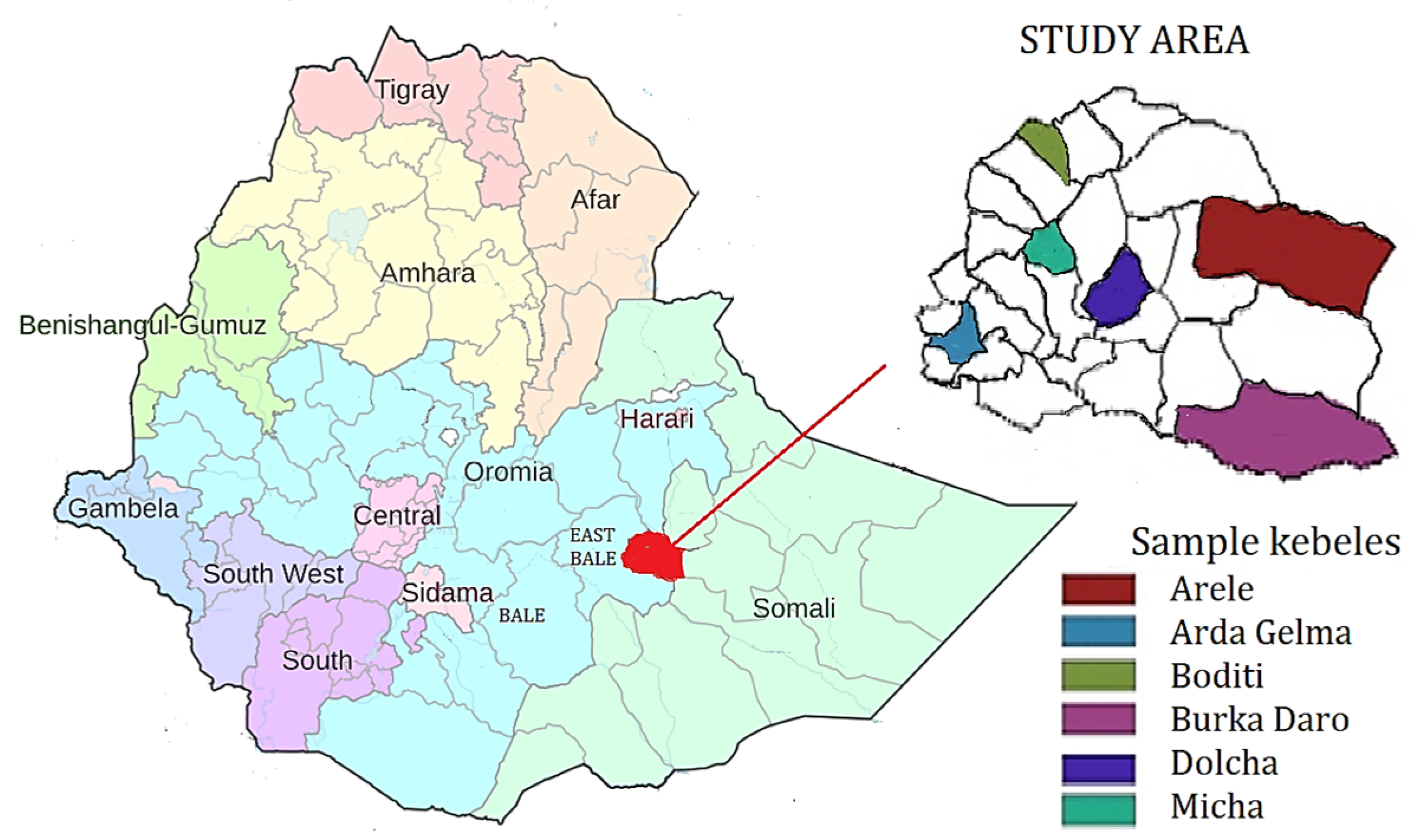

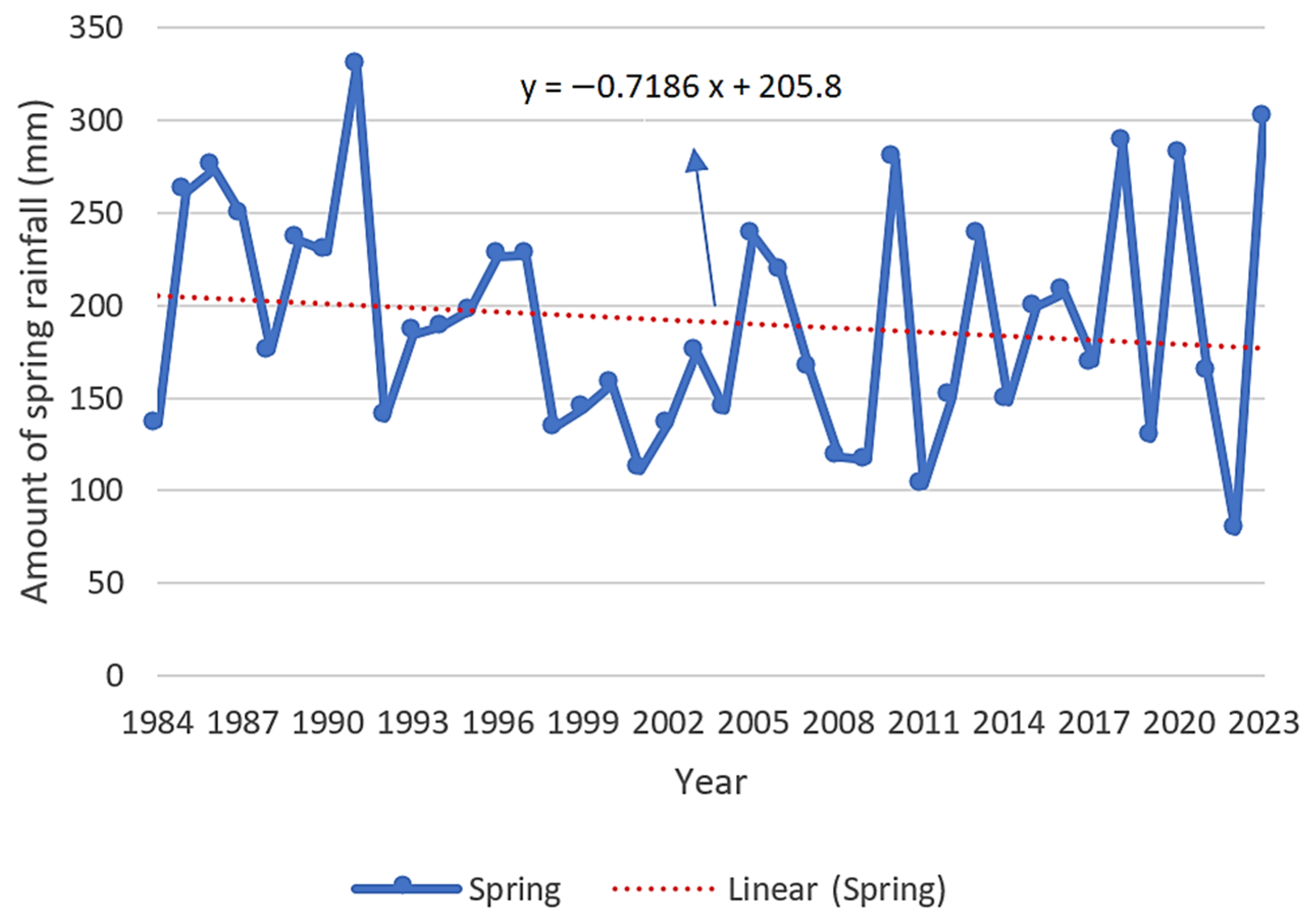
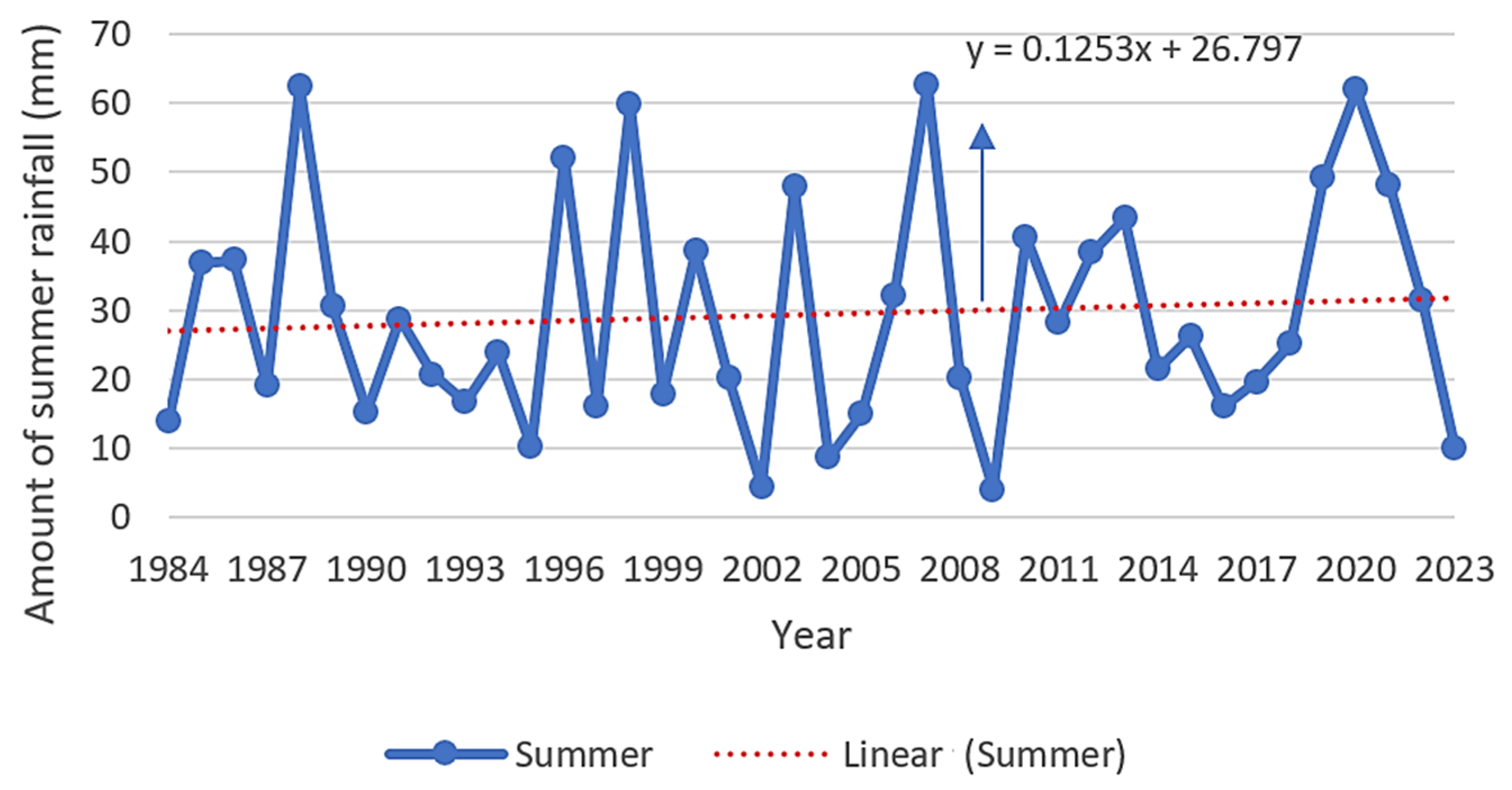

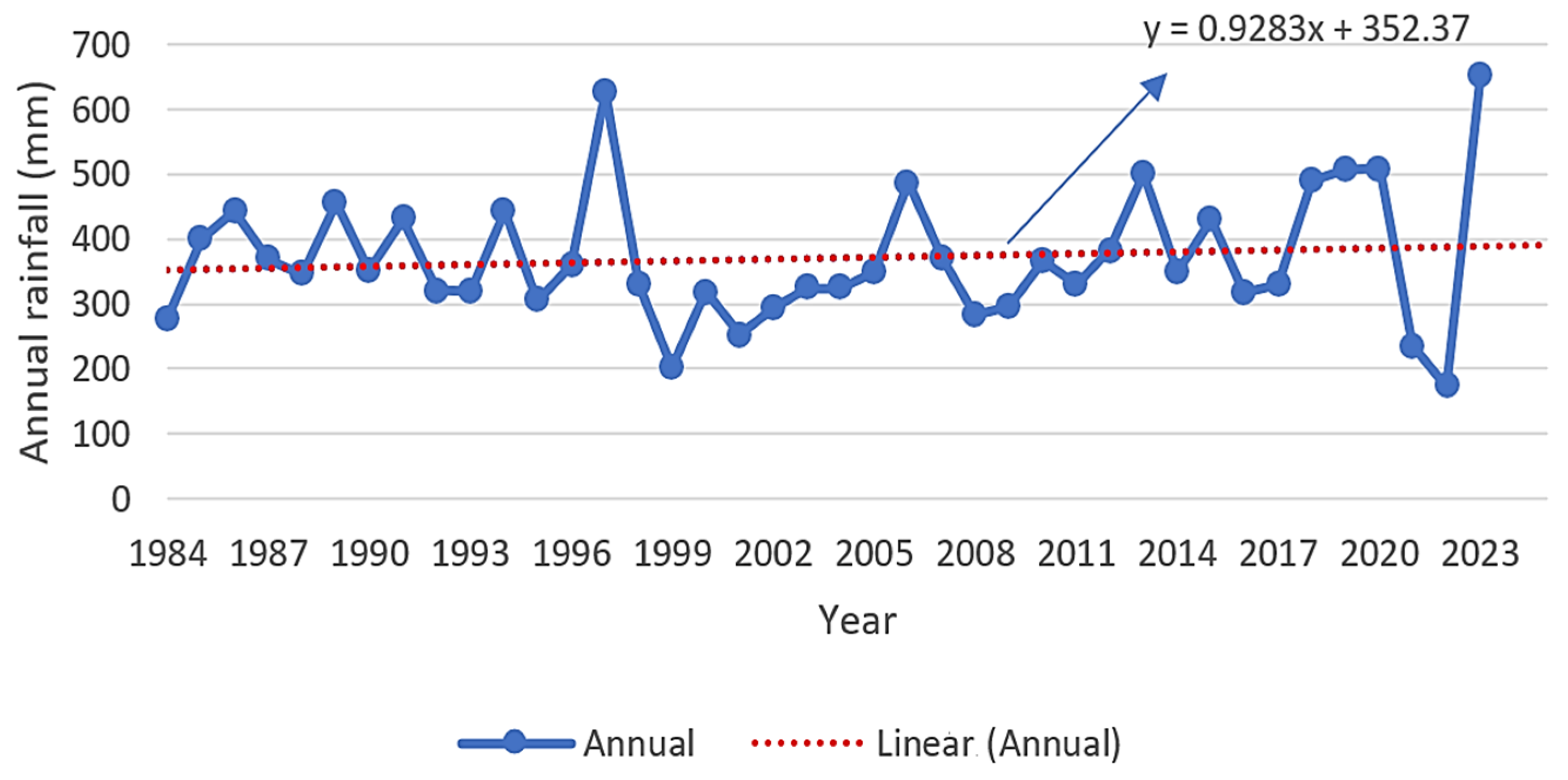
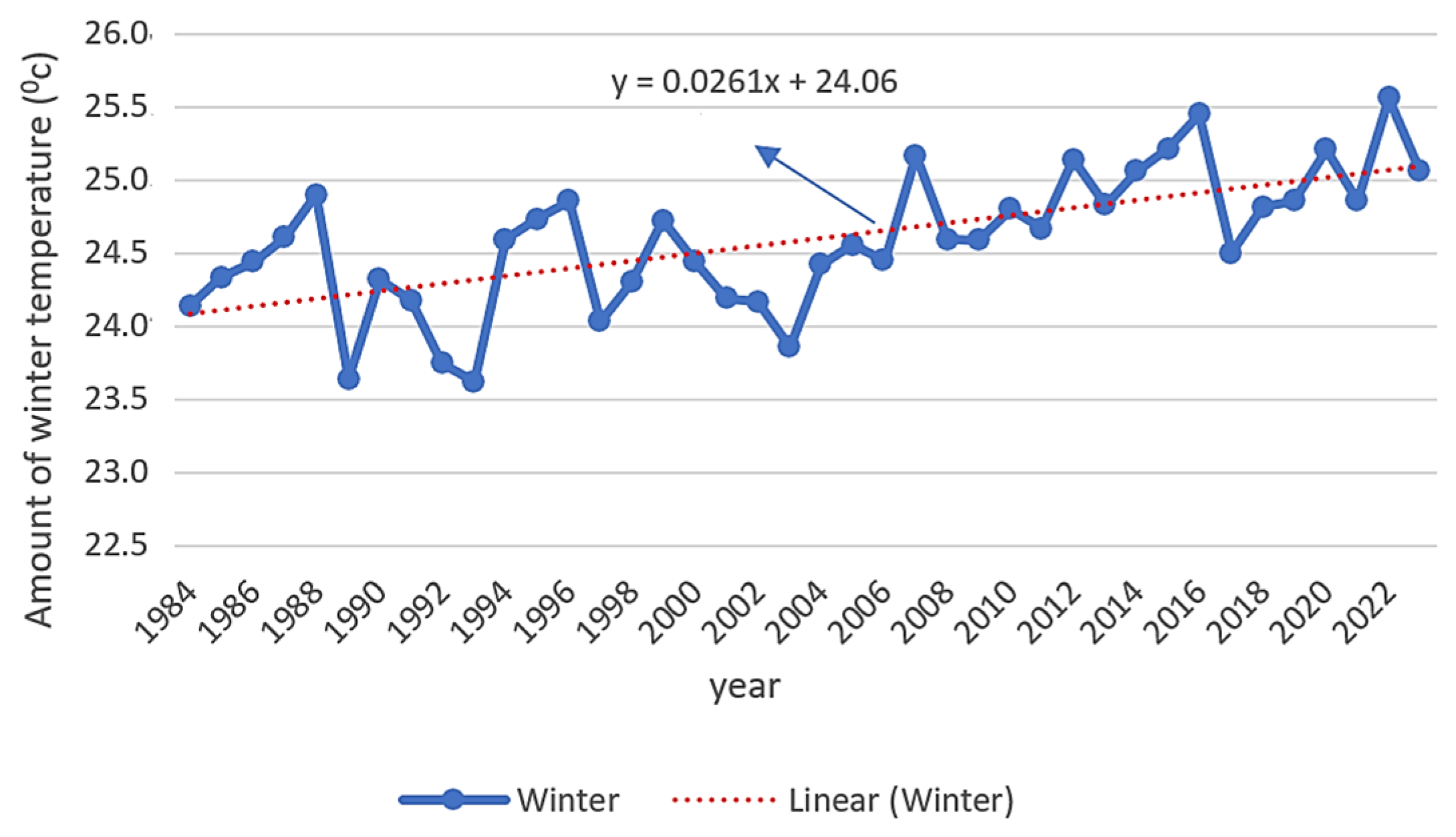
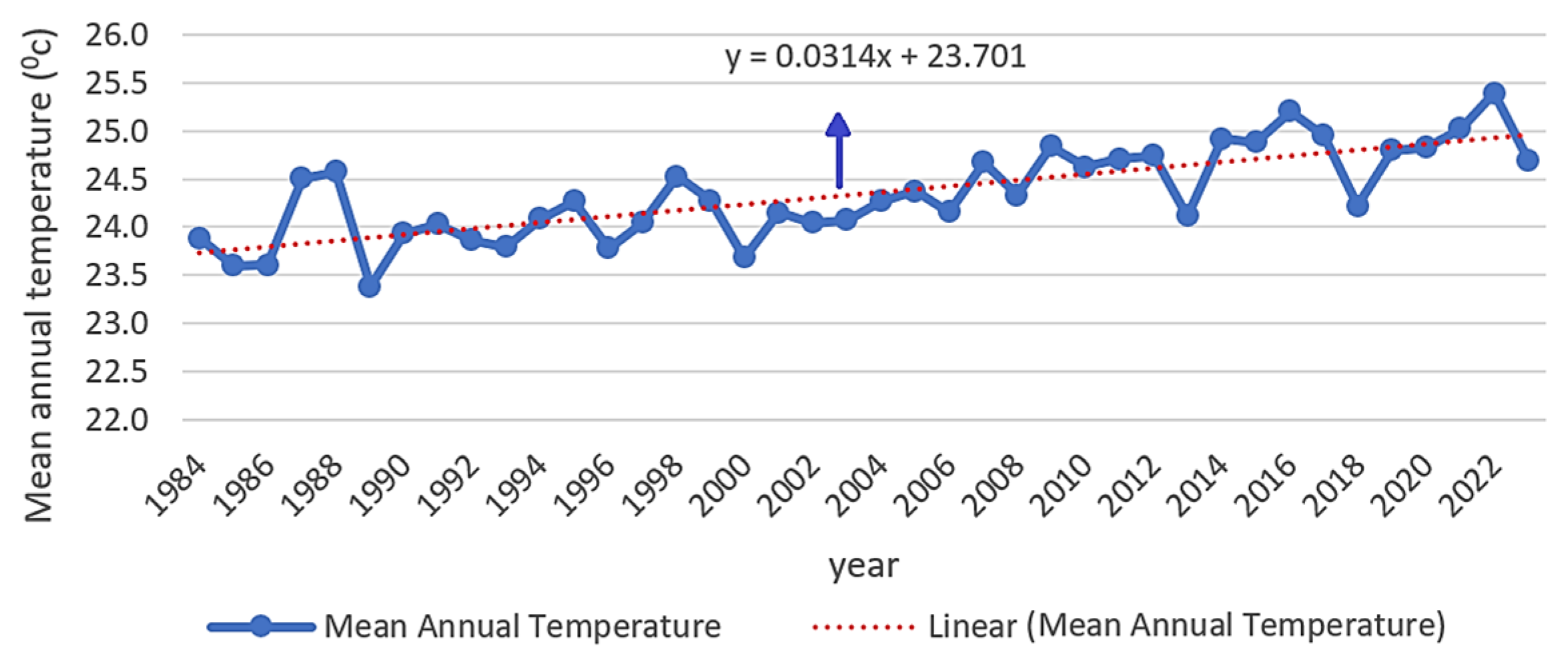
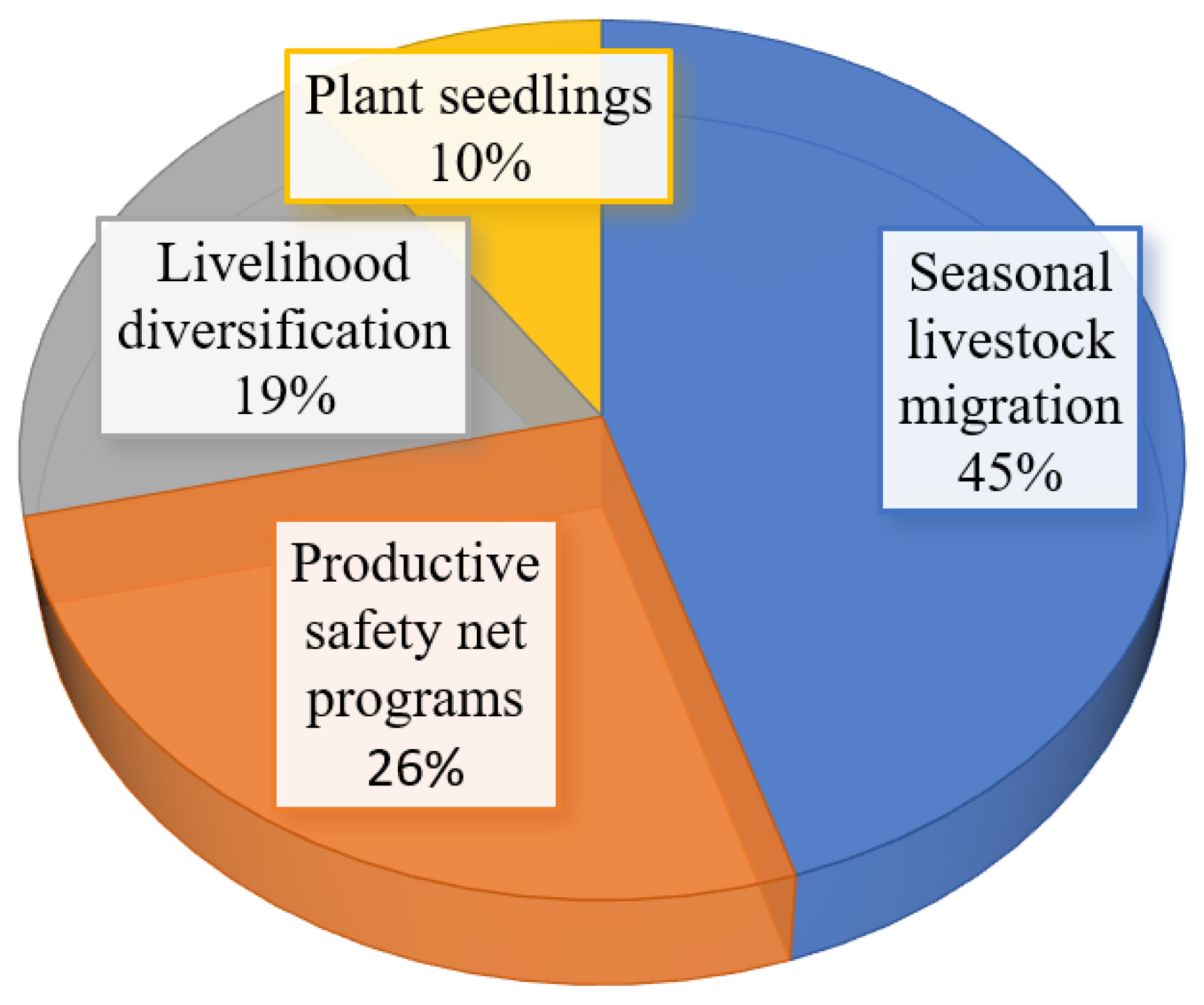
| Name of Kebeles | Total Household | Sample Household |
|---|---|---|
| Arda Gelma | 708 | 64 |
| Arele | 540 | 49 |
| Boditi | 365 | 33 |
| Burka Daro | 485 | 44 |
| Dolcha | 715 | 65 |
| Mica | 1058 | 95 |
| Total | 3871 | 350 |
| SN | Strategies | Categories | Reasoning |
|---|---|---|---|
| 1 | Seasonal Livestock Migration | Adaptation strategies | Traditional, long-term practice to manage climatic variability sustainably. |
| 2 | Productive Safety Net Programs (PSNPs) | Coping strategies | Short-term relief to address immediate climate shocks (e.g., climate variability such as drought). |
| 3 | Livelihood Diversification | Adaptation strategies | Long-term approach to reduce climate risks by diversifying income sources. |
| 4 | Seedling Planting | Adaptation strategies | Forward-looking environmental strategy for resilience and land restoration. |
| I. Dummy Variables | Number of Responses | % of Responses | Number of Responses | % of Responses | |
|---|---|---|---|---|---|
| Male | Female | ||||
| 1 | Sex (SEX) | 240 | 68.6 | 110 | 31.4 |
| Not accessible | Accessible | ||||
| 2 | Access to credit (CREDIT) | 212 | 60.6 | 138 | 39.4 |
| 3 | Access to mass media (MEDIA) | 70 | 22.3 | 272 | 77.7 |
| 4 | Access to veterinary extension services (ACCT) | 237 | 67.7 | 113 | 32.3 |
| 5 | Access to rangeland (RNGLD) | 82 | 23.4 | 268 | 76.6 |
| II. Quantitative variables | Mean | Maximum | Minimum | Std. dev. | |
| 6 | Age of the household head (AGE) | 44 | 82 | 20 | 13.02 |
| 7 | Total family size in the household (FAMSZ) | 8 | 17 | 0 | 2.73 |
| 8 | Education status of the household head (EDUCH) | 2 | 10 | 0 | 2.33 |
| 9 | Tropical livestock unit of holding (LIVEST) | 7 | 65 | 3 | 4.72 |
| 10 | Asset value in USD (ASSET) | 3155 | 10,009 | 486 | 1646 |
| 11 | Distance from nearest market in km (DISMA) | 15.3 | 46 | 0.02 | 16.72 |
| 12 | Annual rainfall in mm | 371.4 | 652 | 172 | 102.2 |
| 13 | Annual temperature in °C | 23.4 | 25.39 | 23.37 | 0.478 |
| Item | Mean Annual RF | Std. Deviation | Coefficient of Variation | Kendall’s Tau | MK-Statistic (S) | p-Value | Sen’s Slope |
|---|---|---|---|---|---|---|---|
| Month | |||||||
| January | 2.74 | 6.620 | 242.05 | −0.072 | −51 | 0.546 | 0.000 |
| February | 5.93 | 13.777 | 232.22 | −0.018 | −12 | 0.892 | 0.000 |
| March | 31.34 | 33.716 | 107.57 | 0.041 | 32 | 0.718 | 0.136 |
| April | 41.04 | 38.499 | 38.100 | −0.062 | −48 | 0.584 | −0.302 |
| May | 58.67 | 32.695 | 55.720 | −0.062 | −48 | 0.584 | −0.351 |
| June | 7.53 | 10.150 | 134.66 | −0.083 | −65 | 0.456 | −0.035 |
| July | 12.71 | 10.903 | 85.780 | −0.012 | −9 | 0.926 | −0.008 |
| August | 9.12 | 9.754 | 106.98 | 0.090 | 70 | 0.421 | 0.067 |
| September | 61.90 | 12.397 | 104.17 | 0.108 | 84 | 0.034 ** | 0.096 |
| October | 44.80 | 41.643 | 92.953 | 0.315 | 246 | 0.004 * | 1.284 |
| November | 75.27 | 42.045 | 55.853 | 0.216 | 118 | 0.047 ** | 0.072 |
| December | 10.33 | 17.227 | 166.80 | −0.153 | −161 | 0.173 | −0.975 |
| Season | |||||||
| Winter | 18.99 | 24.077 | 126.75 | −0.159 | −124 | 0.152 | −0.129 |
| Spring | 191.06 | 61.626 | 32.253 | −0.105 | −82 | 0.345 | −1.044 |
| Summer | 29.36 | 16.588 | 56.490 | 0.064 | 50 | 0.568 | 0.117 |
| Autumn | 131.97 | 76.340 | 57.843 | 0.208 | 162 | 0.041 ** | 1.935 |
| Annual | 371.40 | 102.214 | 27.521 | 0.062 | 48 | 0.449 | 0.653 |
| Item | Mean | Std. Deviation | Coeff. of Variation | Kendall’s Tau | MK Statistic (MKS) | p-Value | Sen’s Slope |
|---|---|---|---|---|---|---|---|
| Month | |||||||
| January | 24.49 | 0.596 | 2.432 | 0.362 | 282 | 0.001 * | 0.025 |
| February | 25.69 | 0.675 | 2.625 | 0.392 | 306 | 0.000 * | 0.026 |
| March | 25.69 | 1.019 | 3.967 | 0.174 | 136 | 0.116 | 0.022 |
| April | 23.94 | 0.983 | 4.107 | 0.262 | 204 | 0.018 * | 0.035 |
| May | 24.01 | 0.932 | 3.880 | 0.297 | 232 | 0.007 * | 0.033 |
| June | 24.85 | 0.954 | 3.838 | 0.372 | 290 | 0.000 * | 0.042 |
| July | 23.88 | 0.813 | 3.404 | 0.305 | 238 | 0.006 * | 0.035 |
| August | 24.42 | 0.733 | 3.003 | 0.418 | 326 | 0.000 * | 0.039 |
| September | 25.39 | 0.784 | 3.089 | 0.515 | 402 | 0.000 * | 0.049 |
| October | 23.35 | 0.894 | 3.830 | 0.300 | 234 | 0.007 * | 0.036 |
| November | 22.79 | 0.892 | 3.913 | 0.005 | 4 | 0.972 | 0.001 |
| December | 23.59 | 0.848 | 3.594 | 0.205 | 160 | 0.064 | 0.021 |
| Season | |||||||
| Winter | 24.59 | 0.465 | 1.892 | 0.482 | 376 | 0.001 * | 0.026 |
| Spring | 24.55 | 0.738 | 3.006 | 0.331 | 258 | 0.003 * | 0.035 |
| Summer | 24.38 | 0.689 | 2.826 | 0.444 | 346 | 0.000 * | 0.038 |
| Autumn | 23.84 | 0.676 | 2.836 | 0.385 | 300 | 0.000 * | 0.033 |
| Annual | 24.34 | 0.478 | 1.966 | 0.603 | 492 | 0.000 * | 0.034 |
| Variables | SLM | PSNP | LD | PS | ||||
|---|---|---|---|---|---|---|---|---|
| Coefficient | p-Value | Coefficient | p-Value | Coefficient | p-Value | Coefficient | p-Value | |
| SEX | −0.09 | 0.111 | 0.05 | 0.355 | 0.04 | 0.229 | 0.075 | 0.937 |
| AGE | 0.035 | 0.025 ** | −0.001 | 0.035 ** | 0.004 | 0.816 | −0.048 | 0.654 |
| FAMSZ | 0.02 | 0.116 | −0.01 | 0.21 | −0.01 | 0.182 | 0.008 | 0.584 |
| EDUCH | 0.04 | 0.00 * | 0.03 | 0.001 * | 0.02 | 0.001 * | 0.02 | 0.001 * |
| CREDT | −0.01 | 0.786 | −0.05 | 0.314 | 0.054 | 0.049 ** | 0.06 | 0.09 |
| LIVEST | 0.025 | 0.05 ** | −0.00 | 0.496 | 0.036 | 0.008 * | −0.084 | 0.815 |
| ASSET | −0.045 | 0.00 * | 0.035 | 0.769 | 0.180 | 0.023 ** | 0.001 | 0.501 |
| MEDIA | −0.02 | 0.693 | 0.01 | 0.925 | 0.06 | 0.046 ** | 0.03 | 0.045 ** |
| ACCT | 0.16 | 0.005 * | −0.12 | 0.27 | −0.03 | 0.254 | −0.45 | 0.925 |
| DISMA | −0.32 | 0.542 | 0.082 | 0.567 | −0.009 | 0.00 * | 0.007 | 0.00 * |
| RNGLD | 0.47 | 0.00 * | 0.37 | 0.25 | −0.64 | 0.00 * | −0.20 | 0.00 * |
| Constant | −0.05 | 0.717 | 0.22 | 0.105 | 0.67 | 0.00 * | 0.16 | 0.081 |
Disclaimer/Publisher’s Note: The statements, opinions and data contained in all publications are solely those of the individual author(s) and contributor(s) and not of MDPI and/or the editor(s). MDPI and/or the editor(s) disclaim responsibility for any injury to people or property resulting from any ideas, methods, instructions or products referred to in the content. |
© 2024 by the authors. Licensee MDPI, Basel, Switzerland. This article is an open access article distributed under the terms and conditions of the Creative Commons Attribution (CC BY) license (https://creativecommons.org/licenses/by/4.0/).
Share and Cite
Gebbisa, M.B.; Bacsi, Z. Climate Variability and Adaptation Strategies in a Pastoralist Area of the Eastern Bale Zone: The Case of Sawena District, Ethiopia. Appl. Sci. 2025, 15, 69. https://doi.org/10.3390/app15010069
Gebbisa MB, Bacsi Z. Climate Variability and Adaptation Strategies in a Pastoralist Area of the Eastern Bale Zone: The Case of Sawena District, Ethiopia. Applied Sciences. 2025; 15(1):69. https://doi.org/10.3390/app15010069
Chicago/Turabian StyleGebbisa, Mesfin Bekele, and Zsuzsanna Bacsi. 2025. "Climate Variability and Adaptation Strategies in a Pastoralist Area of the Eastern Bale Zone: The Case of Sawena District, Ethiopia" Applied Sciences 15, no. 1: 69. https://doi.org/10.3390/app15010069
APA StyleGebbisa, M. B., & Bacsi, Z. (2025). Climate Variability and Adaptation Strategies in a Pastoralist Area of the Eastern Bale Zone: The Case of Sawena District, Ethiopia. Applied Sciences, 15(1), 69. https://doi.org/10.3390/app15010069







